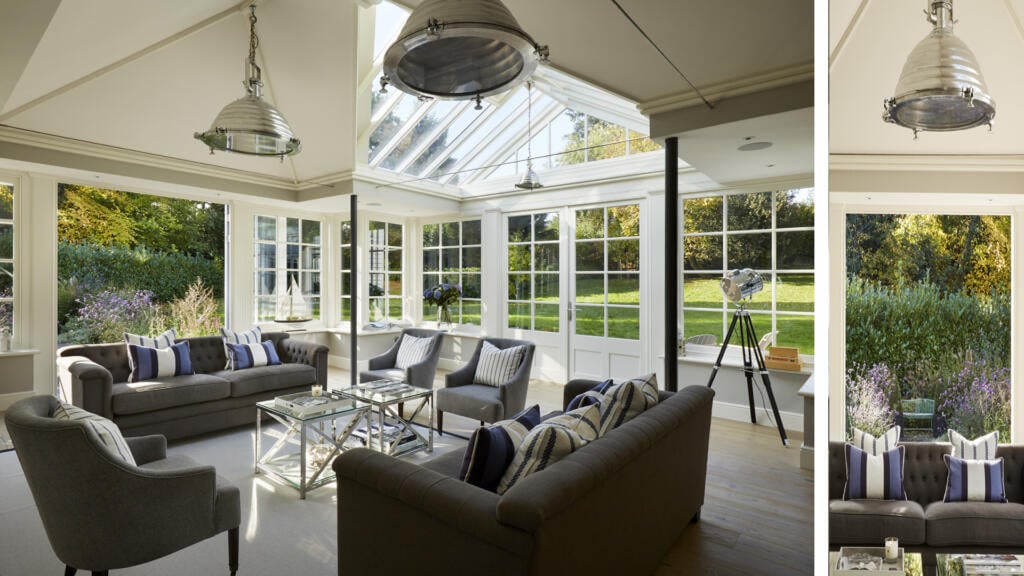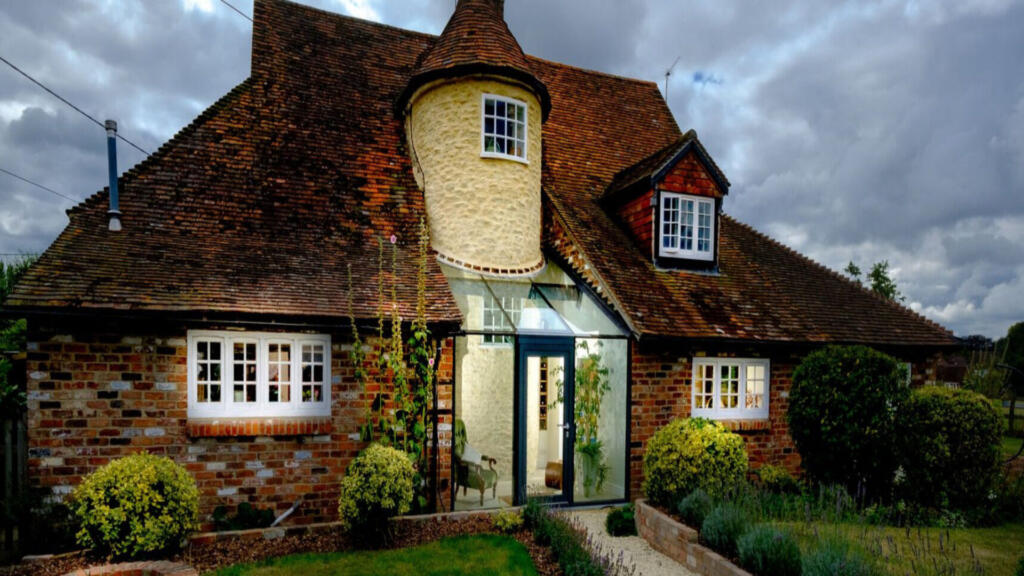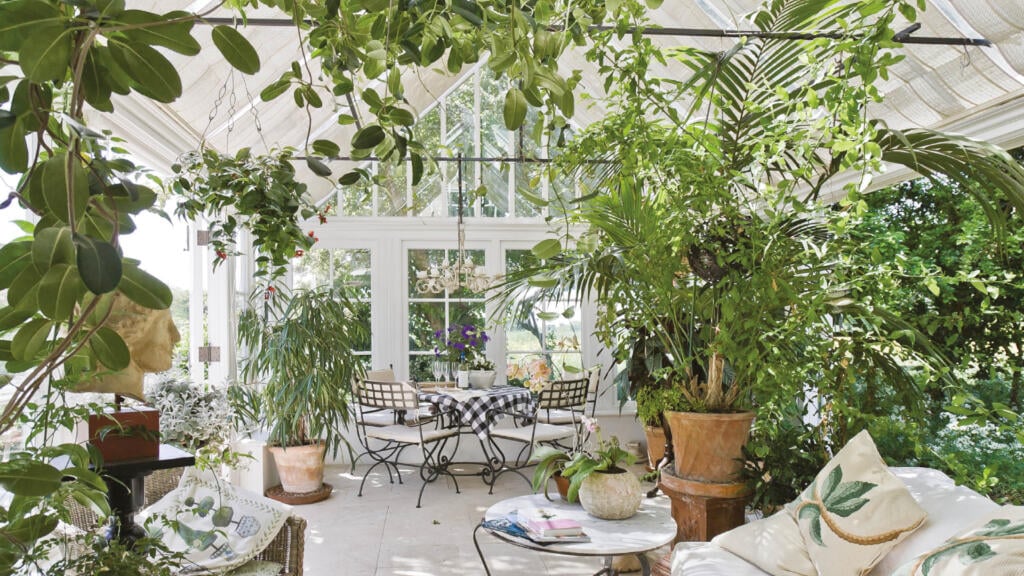
Conservatory lighting a little lacklustre? Here are 10 illuminating ideas
Sarah Harley
From family meals to dinner parties, we show you 11 ways to create the perfect dining experience
If your perfect mealtime setting involves light, space, ambiance and day-to-night location, a conservatory dining room can be the perfect solution.
Wrapped in glazing and served up with a generous dose of height, architectural features, and garden views, your conservatory diningspace can merit the equivalent of a Michelin star in design terms.
If your perfect mealtime setting involves light, space, ambiance and day-to-night location, a conservatory dining room can be the perfect solution.
Wrapped in glazing and served up with a generous dose of height, architectural features, and garden views, your conservatory diningspace can merit the equivalent of a Michelin star in design terms.
 Credit: Vale Garden Houses
Credit: Vale Garden HousesFrom elegant, pared-back spaces to cosy, family-oriented rooms, we’ve got something on the menu to suit most tastes.
For a conservatory dining room that oozes elegance but combines comfort with a considered interior design approach, curate your scheme using light woods, weathered finishes, and sculptural shapes.
Run a series of antiqued mirror tiles along one and display a large antique mirror at the end of the table to enhance the sense of light and space. Using mirrors will also bounce light around and add a complementary glow to your guests faces at nighttime.
For a subtle nighttime look, hang a crystal droplet chandelier above a dining table and keep wall lighting to a minimum. For more palatable daytime dining, make sure you use conservatory blinds on roof lanterns or glazed ceilings.
 Credit: Vale Garden Houses
Credit: Vale Garden HousesIf the most popular dining request from your family and friends is to savour the view, keep your interior design low-key and ensure nothing detracts from the landscape outside.
In a traditional orangery, use a metal framed lantern-style light, and a long farmhouse style wooden table, and add functional rattan chairs. Pop a simple posy of garden-fresh blooms on the table for decoration and leave the space uncluttered so that nothing detracts from the spectacular setting.
 Credit: Vale Garden Houses
Credit: Vale Garden Houses“Creating a light-filled space is clearly one of the many benefits of an orangery or conservatory, says Karen Bell, creative director at David Salisbury, “and this makes it the ideal environment to host a dining room.”
If your interior design taste is more modern, choose black, white and shades of grey for a sleek and sophisticated scheme.
Add depth with textured fabrics on comfy seating and line the walls with wood-grain panels. Hang a modern style candelabra to bring a sense of drama to your vaulted roof and keep finishing touches to a minimum with sculptural plants such as orchids and foraged twigs.
Define the dining space with a large sisal rug bordered in black and add a beautiful black Labrador as the dishy dog of the day (optional, of course!).
 Credit: Vale Garden Houses
Credit: Vale Garden HousesChoosing whether to add window coverings to a contemporary scheme is down to location, says Ash Lane, marketing designer at Vale Garden Houses.
“A south-facing extension will enjoy the most amount of natural light during the day, and is a perfect to enjoy breakfast, lunch or dinner,” says Lane. “A fully glazed roof, a feature of a conservatory, or a roof lantern – typically found in an orangery – will help create an atmospheric setting for dinner guests, with potential views of a starry night to add to the occasion.”
Wall panels are very much a growing interior design trend and can be an easy way to add an alternative finish to plain plastered walls. I’m certainly considering using them when I move this year.
If your walls are looking a little bland, wall panels are perfect for adding architectural interest and are available in a range of colours and finishes.
Most ranges claim to be easy to fit by simply gluing or screwing them to a wall. I love these charcoal black slatwall panels, which sit on a black felt backing. As well as having aesthetic value, they have added acoustic benefits, helpful if you live in a noisier environment.
If you prefer your finishes smoother, wood-effect wallpaper can be a good alternative. You can find a good selection at B&Q. It could be an effective update to an existing space if you are considering an easy DIY job over the next bank holiday weekend.
If you only have space for a small conservatory dining room, take advantage of an external wall and add built-in seating. It’ll give ample space for bums on seats and provide extra storage.
Position your seating below your roof to get the best of the natural light and use a colour palette of stone, wood and shades of terracotta. Use a darker shade such as navy in bench seating and dining chairs to ground the scheme.
Hang abstract artwork at the end of the table and add coloured pampas grass to soften the overall look.
 Credit: Carpet Right
Credit: Carpet RightReverse the layout for a standard conservatory design
Although the image shown features a lean-to design in an open-plan design, it will work equally well in a more traditional conservatory that retains the rear wall.
Simply reverse the scheme so that the built-in seating backs onto your home’s external wall and it’ll come with a bonus – a free item on the menu, your garden view.
In a larger space where you have the luxury of both seating and dining areas, call on lighter shades of nature to tie the areas together.
Soft duck egg blues and pastel pinks nod to the outdoors and will help to lighten a darker frame choice.
Combining more classical items such as chandeliers with contemporary, streamline seating like the Verner Panton chair makes for an elegant yet practical scheme. Made from durable dyed-through plastic, the seats are easy to clean and perfect for multi-generational family gatherings with younger visitors.
 Credit: David Salisbury
Credit: David SalisburyInterior design tip
If you want to soften the look or feel of harder chairs, add seating pads designed specifically for the chair, or a sheepskin throw for a cosier feel.
Choosing a chair that works just as well in a living room as it does around a dining table also makes it easier to pop spare seating around the room – handy if unexpected guests join you for a meal.
If your garden serves up a daily lush green view, embrace this in your conservatory dining room design.
Be bold with your décor and choose a dark, earthy sage green for your frame colour. Hang black pendant shades from the apex and mirror your frame colour in your dining chairs.
A dining table surface made from a slab of grained wood will provide an ideal place to display jewel-like pops of colour in the form of glass vases housing your carefully cultivated blooms.
 Credit: David Salisbury
Credit: David SalisburyAdd additional luscious green foliage around the room, and if you aren’t in a south-facing spot, leave windows and roof glazing uncovered to soak up the outdoor atmosphere.
Even on a rainy day we can imagine eating here would feel like you were enjoying a feast served up in the jungle, while at nighttime, the exposed starry sky would provide the perfect side dish.
“A dinner party under the stars or bathed in summer sunshine can be truly magical,” says Annie Blackledge, interior designer at Holloways.
If you prefer open plan to broken plan, unite your kitchen and dining room conservatory space interior design for a natural flow and feel.
Lay light-coloured floor tiles made from hard-wearing ceramic or porcelain in a horizontal pattern to create width. Choose a Shaker style kitchen with its linear design, and mirror its shapes and handles on a bespoke dresser in the dining area.
Painting the dresser in the same shade as walls will also ensure it doesn’t seem too imposing. To create symmetry, bookend the other end of the room with a natural-coloured sofa and coffee table.
 Credit: David Salisbury
Credit: David SalisburyAlthough a sleek worktop may be a more practical choice for a kitchen island, adding a wooden dining table will bring the modern country farmhouse look to the fore. Pick similar wooden shades for breakfast bar stools and coffee tables.
Keep your walls light in colour and pendant lighting simple with glass shades over the dining table and sleek metal lanterns in the kitchen area. Add spotlights around roof lanterns and kitchen islands for a layered conservatory lighting scheme.
If you have a busy, darker, multi-framed panel design in your conservatory window and door frames, add some simple and streamlined elegance to your dining area with upholstered bench seating.
Pair with a sleek glass dining table and elevate your upholstered design with finishing touches such as studded seat backs. Keeping chair leg design to a minimum and using a lighter coloured fabric such as cream leather will create a sophisticated conservatory dining room for any occasion.
“Eating is a time when we can sit and take time to relax, start the day with breakfast, take a lazy lunch or unwind over dinner in the evening,” says Lane, reminding us that “whether dining is formal or casual, a conservatory will create an atmosphere that is a totally unique experience.”
 Credit: David Salisbury
Credit: David SalisburyWith its ability to deal with the effects of harsh sunlight, wicker and rattan were once considered the mainstay of conservatory furniture options. Over time, it’s fair to say they were seen as a more old-fashioned option in conservatory interior design.
But as is often the case in fashion and interior trends, certain looks reappear over time with a more modern twist.
Wicker furniture is one such trend that has arrived back on the menu and looks set to stay.
 Credit: Holloways
Credit: HollowaysAccording to Blackledge: “For seating, cane, rattan and wicker are still the most popular choice among our customers.” She points out that wicker is not a material, but rather a method of weaving. “It can be woven from fine rattan, willow or other natural fibres such as seagrass or banana leaves usually onto a frame of cane.”
For a comfortable yet stylish scheme, choose wicker in shades of taupe and cream and add removable cushions to seating for ease of cleaning. Add a wooden legged table with wicker and glass top and keep your colour scheme garden-like with leafy green foliage and botanical inspired accessories such as ceramic artichoke heads.
If you’re a fan of all things vintage and wear your eco badge with pride, scour local auctions and search online for mid-century and salvaged furniture to create a cosy and eclectic conservatory dining room.
We’ve already shared the benefits of bench seating, and the church pew-like ones in this scheme add a healthy dose of character to their practicality. Mid-century style occasional chairs bring a clear sense of design know-how to the scheme.
 Credit: Westbury Garden Rooms
Credit: Westbury Garden RoomsDark wooden flooring throughout provides a practical yet striking contrast to a lighter colour frame. A simple pendant light will fade away during the daytime but create a warm glow against a dark night sky.
Expose brickwork where possible and decorate with nature inspired accessories. Foraged foliage and soft furnishings featuring animals will tie your scheme to the outdoors. Add a real living animal and you’ve got the recipe for unconditional love.
If your potential conservatory ground space is more square than rectangular, don’t assume your building has to be the same.
“Octagonal conservatories particularly lend themselves to circular dining arrangements, which emphasises their structure and creates a really sociable space,” says Mervyn Montgomery, founder and joint director of Hampton Conservatories.
“The ultimate goal is for an orangery to be flooded with light in designated areas, while also optimised for areas of shade,” he says. “A perfect solution when you’re looking to enjoy a meal without feeling too warm.”
 Credit: Hampton Conservatories
Credit: Hampton ConservatoriesBut of course, given we don’t always find ourselves basking in the sunlight in the UK, Montgomery reminds us of the true value of a conservatory.
“All glazed extensions are well-suited to dining,” he adds, “as the homeowner and their guests can feel at one with the surrounding garden and countryside, no matter what the British weather decides to do!”

Written by Sarah Harley she/her
Published:
Since first picking up a paintbrush and experiencing the joy of re-decorating her bedroom in a questionable red, white and grey scheme as a young teenager, Sarah Harley was hooked on the world of interior design. This obsession even led to a real life ‘Grand Designs’ project in 2005 when she donned a pink hard hat and appeared on TV screens, project managing the renovation and extension of a Grade II listed 17th century Folly in South Wales.
Throughout her career, Sarah has gained an array of experience in several different roles, ranging from copywriting, PR, events management and photography to interior design and home staging. With her two passions being the written word and the joys of a beautifully designed home, Sarah’s mission is to open the door on the world of interiors, inviting readers in to help them work their way through the vast choice of products, ideas and trends so that their own homes can reach their full potential.

Sarah Harley

Sarah Harley

Sarah Harley

Sarah Harley